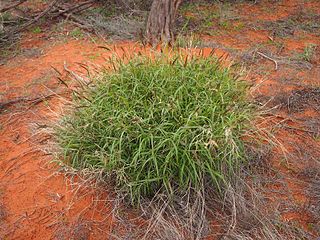
Cenchrus ciliaris is a species of grass native to most of Africa, southern Asia, southern Iran, and the extreme south of Europe (Sicily). Other names by which this grass is known include dhaman grass, anjan grass and koluk katai.

Blue moki is a species of marine ray finned fish belonging to the family Latridae, the trumpeters. It is native to the southwestern Pacific Ocean around New Zealand and occasionally off southeastern Australia at depths of 10 metres (33 ft) and greater. Juveniles inhabit inshore waters, preferring rocky reefs while adults mostly occur in offshore waters forming schools over open bottoms. Some solitary adults can be found on reefs. This species can reach a length of 80 centimetres (31 in) FL, though most do not exceed 63 centimetres (25 in) TL. This species is commercially important and is also popular as a game fish.

Erica ciliaris is a species of heather, known in the British Isles as Dorset heath.
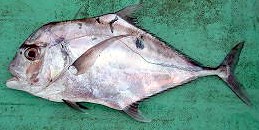
The African pompano, also known as the pennant-fish or threadfin trevally, is a widely distributed species of tropical marine fish in the jack family, Carangidae. The species is found in tropical waters worldwide, with adults often inhabiting coastlines, while juveniles are usually pelagic, floating with ocean currents. The adult African pompano is similar in appearance to the other members of the genus Alectis, with the concave shape of the head near the eyes; the clearest distinguishing feature. The juveniles are similar to other members of Alectis, having long, filamentous dorsal and anal fin tips which are thought to discourage predators. The species lives in depths less than 100 m, consuming a range of crustaceans and small fishes. The species is of minor economic importance, often taken amongst other tropical midwater fishes by hook and line, while juveniles are occasionally caught in beach seines. African pompano are also highly rated game fish, often considered one of the strongest of the jacks in larger sizes.
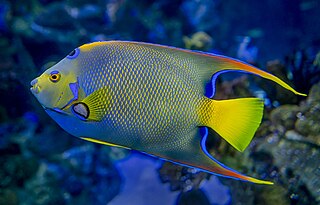
The queen angelfish, also known as the blue angelfish, golden angelfish, or yellow angelfish, is a species of marine angelfish found in the western Atlantic Ocean. It is a benthic warm-water species that lives in coral reefs. It is recognized by its blue and yellow coloration and a distinctive spot or "crown" on its forehead. This crown distinguishes it from the closely related and similar-looking Bermuda blue angelfish, with which it overlaps in range and can interbreed.
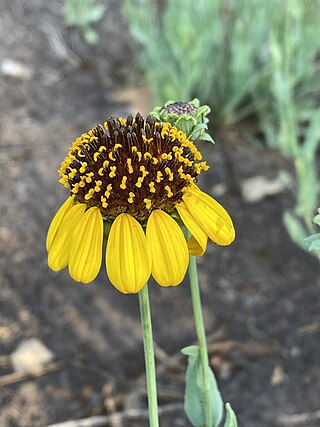
Helianthus ciliaris is a species of sunflower known by the common names Texas blueweed and yerba parda.

Brachyscome ciliaris, commonly known as variable daisy,is a flowering plant in the family Asteraceae it is a small, bushy, perennial herb with white or mauve daisy-like flowers. It grows in the Northern Territory and mainland states of Australia with the exception of South Australia.

Astele is a genus of sea snails, marine gastropod mollusks in the family Calliostomatidae.

Aloiampelos ciliaris, the common climbing-aloe, is a thin-leaved and generally rapidly-growing succulent plant from Southern Africa.

Luidia ciliaris, the seven-armed sea star, is a species of sea star (starfish) in the family Luidiidae. It is found in the eastern Atlantic Ocean and the Mediterranean Sea.
Typhonia bimaculata is a species of bagworm moth native to Madagascar.

Typhonia is a genus of moths of the Psychidae family.

The northern spiny-tailed gecko is a species of lizard in the family Diplodactylidae. The species is endemic to Australia.

Typhonia beatricis is a moth of the Psychidae family. It is found in Switzerland, where it is thought to be an introduced species. The species is possible endemic to the eastern Mediterranean region.

Digitaria ciliaris is a species of grass known by the common names southern crabgrass, tropical finger-grass, tropical crabgrass or summer grass.
Eragrostis ciliaris, the gophertail lovegrass, is a species of grass. It is native to the Old World Tropics; nearly all of Africa, Madagascar, other Indian Ocean islands, the Arabian Peninsula, the Indian Subcontinent, Myanmar, Vietnam, Taiwan and the Philippines and a number of Pacific islands, and has been introduced to the New World Tropics and Subtropics, from the southern United States to Argentina, the Caribbean, and other Pacific islands. Its seeds are edible and nutritious, but quite small and difficult to harvest and handle, so it is usually regarded as a famine food.
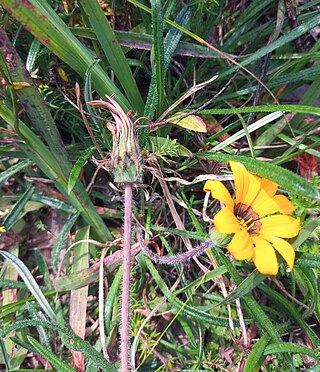
Gazania ciliaris is a species of flowering plant in the family Asteraceae, native predominantly to the Western Cape province, South Africa, where it occurs from Vanrhynsdorp to the Eastern Cape near Joubertina.

Rhynchospora ciliaris, known by the common name of fringed beaksedge, is a member of the sedge family, Cyperaceae. It is a perennial herb, found in wetlands of the southeastern United States, from New Orleans to Morehead City.

Selaginella ciliaris is a plant in the family Selaginellaceae which is native to areas from India and Nepal eastwards to China and Taiwan, and south to northern Australia.
















